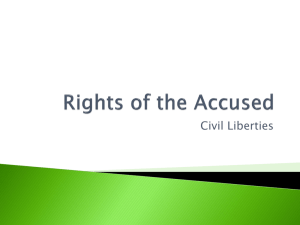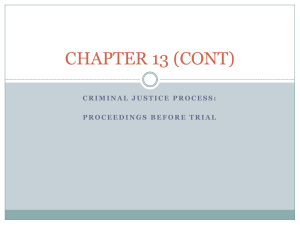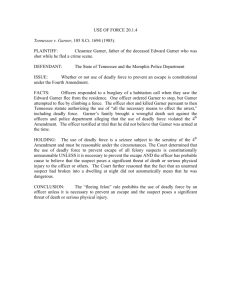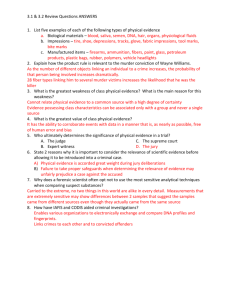View the FAQ Eric Garner Microsoft Word doc
advertisement
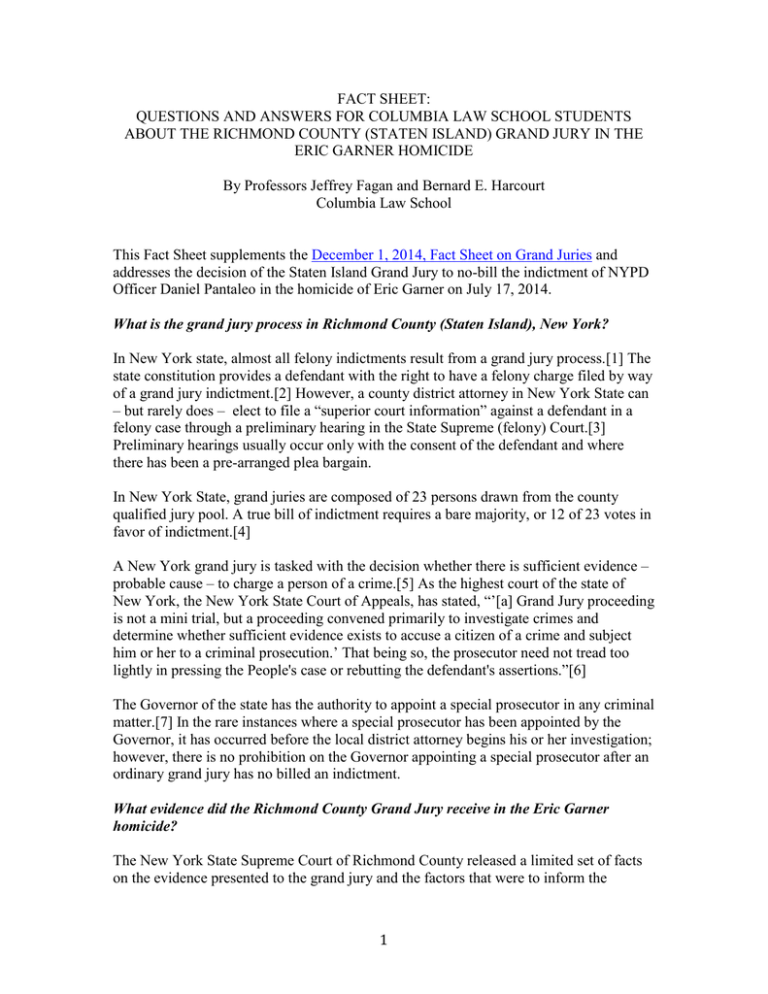
FACT SHEET: QUESTIONS AND ANSWERS FOR COLUMBIA LAW SCHOOL STUDENTS ABOUT THE RICHMOND COUNTY (STATEN ISLAND) GRAND JURY IN THE ERIC GARNER HOMICIDE By Professors Jeffrey Fagan and Bernard E. Harcourt Columbia Law School This Fact Sheet supplements the December 1, 2014, Fact Sheet on Grand Juries and addresses the decision of the Staten Island Grand Jury to no-bill the indictment of NYPD Officer Daniel Pantaleo in the homicide of Eric Garner on July 17, 2014. What is the grand jury process in Richmond County (Staten Island), New York? In New York state, almost all felony indictments result from a grand jury process.[1] The state constitution provides a defendant with the right to have a felony charge filed by way of a grand jury indictment.[2] However, a county district attorney in New York State can – but rarely does – elect to file a “superior court information” against a defendant in a felony case through a preliminary hearing in the State Supreme (felony) Court.[3] Preliminary hearings usually occur only with the consent of the defendant and where there has been a pre-arranged plea bargain. In New York State, grand juries are composed of 23 persons drawn from the county qualified jury pool. A true bill of indictment requires a bare majority, or 12 of 23 votes in favor of indictment.[4] A New York grand jury is tasked with the decision whether there is sufficient evidence – probable cause – to charge a person of a crime.[5] As the highest court of the state of New York, the New York State Court of Appeals, has stated, “’[a] Grand Jury proceeding is not a mini trial, but a proceeding convened primarily to investigate crimes and determine whether sufficient evidence exists to accuse a citizen of a crime and subject him or her to a criminal prosecution.’ That being so, the prosecutor need not tread too lightly in pressing the People's case or rebutting the defendant's assertions.”[6] The Governor of the state has the authority to appoint a special prosecutor in any criminal matter.[7] In the rare instances where a special prosecutor has been appointed by the Governor, it has occurred before the local district attorney begins his or her investigation; however, there is no prohibition on the Governor appointing a special prosecutor after an ordinary grand jury has no billed an indictment. What evidence did the Richmond County Grand Jury receive in the Eric Garner homicide? The New York State Supreme Court of Richmond County released a limited set of facts on the evidence presented to the grand jury and the factors that were to inform the 1 decision of the grand jury.[8] The disclosure was limited to a statement of the following facts: 1) The Grand Jury sat for nine weeks. 2) It heard testimony from 50 witnesses, 22 of whom were civilians. The rest were police officers, emergency medical personnel, and medical professionals including forensic experts. 3) Sixty (60) exhibits were admitted into evidence, including four videos, documentation of NYPD policies and procedures, medical records describing the treatment of the deceased, photographs of the scene, autopsy photographs, and records describing NYPD training 4) The Grand Jury received, from the District Attorney, training on relevant principles of law, including N.Y.P.L. § 35.30, the statute describing when an officer can use physical force in making an arrest. Four of the five police officers involved in the arrest and subsequent death of Eric Garner were given immunity from criminal prosecution by the Richmond County prosecutor. In addition to receiving the report of the Office of the City Medical Examiner, the Grand Jury also received the report of a private medical examiner retained by the Garner family. Both medical examiners agreed that Garner died as a result of neck and chest compression; the NYC medical examiner also reported that Garner’s asthma, obesity and heart condition contributed to his death.[9] What were the questions before the grand jury in the Eric Garner homicide? The medical examiner for the City of New York classified Eric Garner’s death as a homicide.[10] The grand jury was tasked with deciding whether there was sufficient evidence to believe that Officer Pantaleo (1) violated any of the homicide provisions of the New York Penal Law and (2) whether Officer Pantaleo’s actions were justified as the legal use of force by a law enforcement officer in effecting an arrest. New York Penal Law § 125.00 defines several of classes of criminal homicide, ranging from Class A to Class E felonies.[11] In the Garner death, the grand jury could have been presented with the following criminal homicide charges: §125.10 Criminally negligent homicide: “A person is guilty of criminally negligent homicide when, with criminal negligence, he causes the death of another person.” (Criminally negligent homicide is a class E felony). §125.15 Manslaughter in the second degree: “A person is guilty of manslaughter in the second degree when … he recklessly causes the death of another person.” (Manslaughter in the second degree is a class C felony). § 125.20 Manslaughter in the first degree: “A person is guilty of manslaughter in the first degree when … with intent to cause serious physical injury to another 2 person, he causes the death of such person or of a third person.” (Manslaughter in the first degree is a class B felony). § 120.20 Reckless endangerment in the second degree: “A person is guilty of reckless endangerment in the second degree when he recklessly engages in conduct which creates a substantial risk of serious physical injury to another person.” (Reckless endangerment in the second degree is a class A misdemeanor). §121.11 Criminal obstruction of breathing or blood circulation: “A person is guilty of criminal obstruction of breathing or blood circulation when, with intent to impede the normal breathing or circulation of the blood of another person, he or she (a.) applies pressure on the throat or neck of such person; or (b.) blocks the nose or mouth of such person.” (Criminal obstruction of breathing or blood circulation is a class A misdemeanor.) The second question was whether Officer Pantaleo’s actions were justified, therefore removing any criminal responsibility. Under NYPL § 35.30.1, a police officer is justified in using physical force in making an arrest only when it is reasonable and necessary to effectuate the arrest. Specifically, the New York statute provides: “A police officer or a peace officer, in the course of effecting or attempting to effect an arrest, or of preventing or attempting to prevent the escape from custody, of a person whom he or she reasonably believes to have committed an offense, may use physical force when and to the extent he or she reasonably believes such to be necessary to effect the arrest, or to prevent the escape from custody, or in self-defense or to defend a third person from what he or she reasonably believes to be the use or imminent use of physical force.”[12] Was there probable cause to indict for criminal homicide? Yes. First, the Medical Examiner (ME) for the City of New York conducted an autopsy and concluded that the cause of death was a homicide—in other words, that the death was caused by the acts of one or more other human beings. Second, the ME ruled that Mr. Garner’s death was caused by “compression of neck (choke hold), compression of chest and prone positioning during physical restraint by police.”[13] The ME report, which we have physically seen, specifically states “compression of the neck (chokehold)”.[14] The compression of Garner’s neck was a result of Pantaleo’s arm around his neck. (Whether it was technically a ‘chokehold’ is in dispute, [15] with Officer Pantaleo claiming it was a “take down maneuver.[16] What is clear from the video is that Officer Pantaleo put his arm around Mr. Garner’s neck and that Mr. Garner stated that he could not breathe while Officer Pantaleo applied neck and chest compression. Despite the ban on ‘chokeholds’ by the NYPD, a 2014 report by the 3 Citizen Complaint Review Board shows that they continue to be used, and that officers are rarely disciplined for doing so.[17]) Third, video evidence suggests, and the ME report confirms, that there was strong pressure applied to Garner’s neck, characteristic of a “chokehold.”[18] Pressure was applied around the neck of Mr. Garner by Officer Pantaleo.[19] The video evidence, widely available on various media and websites, shows that at the outset of the encounter between Mr. Garner and the five officers, Officer Pantaleo used force applied to his neck area to subdue Mr. Garner while placing him on the ground. Once subdued, the video shows that Officer Pantaleo continued to apply force using a chokehold to Mr. Garner while he was on the ground. Throughout this time, both before and after Mr. Garner was on the ground, he repeatedly said “I can’t breathe.” He said this audibly 11 times during the encounter before Mr. Garner lost consciousness. Although Officer Pantaleo was permitted by law to “reasonably” use “necessary force” to effectuate the arrest of Mr. Garner, once Mr. Garner was on the ground and subdued, and while he repeatedly stated that he could not breathe, the continued use of force was objectively unreasonable. The standard on justification for police officers in New York under NYPL §35.30 is an objective one. Reasonableness is to be determined from the perspective of a reasonable police officer on the scene.[20] In this case, once the suspect was subdued and no longer resisting, the continued application of force may have become unreasonable. This would be a question for a petit jury at trial. Are chokeholds banned under NYPD policy? The use of chokeholds by police officers is banned by NYPD policy.[21] Chokeholds were permissible until then-Police Commissioner Benjamin Ward sharply limited their use pursuant to a 1985 order.[22]. The use of chokeholds was later banned by the NYPD in 1993[23] by then-Police Commissioner Raymond Kelly following the 1992 death in police custody of Federico Pereira caused by “traumatic asphyxia.”[24] The 1993 ban made no distinctions between various types of holds, and also banned other restraint tactics such as “standing on a suspect’s chest or transporting the suspect in a face-down position that might impede his breathing.”[25]. In addition to the question of the continued and unnecessary use of excessive force, the type of force used by Officer Pantaleo was – by virtue of its ban – unreasonable under NYPD policy. Specifically, the video evidence shows that Officer Pantaleo used sustained neck compression to initially subdue Mr. Garner, and then, according to statements by his attorney, he used a “take down maneuver” to place Mr. Garner on the ground.[26] Once subdued and on the ground, the video shows that Officer Pantaleo continued to apply pressure to Mr. Garner’s neck and chest. Throughout second phase of the encounter, Mr. Garner continued to repeat that he could not breathe. The video evidence shows that he stated “I can’t breathe” 11 times. What exactly is a “chokehold”? 4 Under NYPD policy regarding the use of force, contained in the NYPD Patrol Guide, “a chokehold shall include, but is not limited to, any pressure to the throat or windpipe, which may prevent or hinder breathing or reduce intake of air.”[27] According to a recent analysis by the New York City Civilian Complaint Review Board of chokehold incidents, “the Department policy appears to be broad in its understanding of respiratory neck restraints….The definition of a chokehold is a two-pronged test. The first prong is the definition of a chokehold as ‘any pressure to the throat or windpipe.’ The second prong is the definition of any pressure that ‘may prevent or hinder breathing or reduce intake of air.’ ”[28] It has been said that there is a difference between a “chokehold,” a “headlock,” and a “take down maneuver taught at the Police Academy.” There are varying definitions of a chokehold. It is important to distinguish among these types, as they can pose different threats to the life of a suspect. In particular, these definitions differ on where the pressure from a forearm is placed around the suspect’s neck. Specifically, chokeholds can be distinguished between “blood chokes” and “air chokes.” A “blood choke” is the application of force to the sides of the neck of the suspect to constrict the carotid artery, thereby stemming the flow of blood to the brain. After a short time, the suspect will go unconscious. However, if the officer and the suspect are not stationary, the danger exists that the officer’s pressure will slip or move to the front of the neck, constricting the windpipe and thereby stemming the flow of oxygen to the lungs and the brain. That is, once the forearm is placed in the front of the suspect’s neck, the chokehold becomes an “air choke.” This can cause death by stopping the suspect from breathing. The NYPD use of force policy defines a “stay away from the neck” rule to avoid just these situations, and is one of the central reasons why chokeholds are banned by NYPD policy. Whether the exact maneuver qualified as a chokehold or anything else would be a question to be determined by a trial jury. What might happen next? The district attorney for Staten Island could convene a second grand jury to consider the evidence. This has happened, for instance, in Staten Island, in response to contamination of one of the grand jurors.[29] Also, a second grand jury was convened in a police shooting in the Bronx in 2012, but only after the report of the first grand jury was ruled invalid due to faulty instructions given by an Assistant District Attorney.[30] The Governor of the state of New York could appoint a special prosecutor to present evidence before another grand jury. Former Governor Mario Cuomo, for instance, 5 appointed a special prosecutor in 1986 after the Howard Beach incident.[31] However, current Governor Cuomo immediately stated after the no bill that further investigations into the Garner death should be conducted by federal authorities.[32] The United States Department of Justice has announced a federal criminal civil rights investigation.[33] Why was Mr. Garner arrested in this incident? The police officers were engaged in “broken windows policing”[34] and were arresting Mr. Garner for a “quality-of-life” offense, the sale of individual cigarettes. No alternatives to arrest were employed in the encounter with Mr. Garner. There is no reliable evidence that “broken windows policing” is an effective law enforcement strategy.[35] “Broken windows policing” was introduced under former Mayor Rudy Giuliani and his first police commissioner, William Bratton, in 1994. It resulted in a 68% increase in allegations of police misconduct to the CCRB over the following three years.[36] “Broken windows policing” was reintroduced under Mayor de Blasio and his police commissioner, William Bratton, in 2014. Jeffrey Fagan, Isidor and Seville Sulzbacher Professor of Law Bernard E. Harcourt, Isidor and Seville Sulzbacher Professor of Law and Director, Columbia Center for Contemporary Critical Thought Columbia Law School New York, NY January 23, 2015 at noon. NOTES 1 McKinney's Consolidated Laws of New York Annotated, Criminal Procedure Law § 1.20 (Definitions of terms of general use in this chapter) stating that “’Accusatory instrument’ means an indictment, … an information, a simplified information, a prosecutor's information, a superior court information, a misdemeanor complaint or a felony complaint.” 2 N.Y. Const. art. I, § 6. 3 NY Criminal Procedure Law, §195.10; see generally NY Criminal Procedure Law § 190.05 & §190.25; see also David Anthony Conforti, “CPL § 195.10: Criminal Defendant May Not Waive Grand Jury Indictment and Consent to Be Prosecuted by Superior Court Information After Indictment Is Filed,” St. John's Law Review, Volume 62, Issue 4, (June 2012). 4 McKinney's Consolidated Laws of New York Annotated, § 190.25 (Grand jury; proceedings and operation in general). 6 People v. D’Amico, 76 NY2d 877, 880 (1990) (ruling that "an order holding defendant for Grand Jury action requires a judicial determination that probable cause exists to believe the defendant committed a felony.” 6 People v Thompson, 22 N.Y.3d 687 (2014) (citing Lancaster, 69 N.Y.2d at 30, 511 N.Y.S.2d 559, 503 N.E.2d 990 [internal quotation marks and citations omitted]). 7 N.Y. Exec. Law § 63(2) (McKinney 1982) (requiring the state attorney general, at the direction of the Governor, to supersede the authority of any district attorney in the investigation and prosecution of a particular criminal proceeding or action). See, Lawrence T. Kurlander and Valerie Friedlander, Perilous Executive Power – Perspective on Special Prosecutors in New York, 16 Hofstra L. Rev. 35 (1987). 8 In the Matter of the Application of the District Attorney of Richmond County, for an order Pursuant to C.P.L. 190.25(4) permitting the public disclosure of the nature of certain Grand Jury evidence and the decision of the Grand Jury, Index 80294/14, Hon. Stephen J. Rooney, December 4, 2014 9 See Giri Nathan, “Eric Garner Died from Chokehold While in Police Custody,” TIME, August 1, 2014, at http://time.com/3071288/eric-garner-chokehold-death-nypd-medicalexaminer/. The police report states that Mr. Garner died from heart failure in the ambulance on the way to the hospital. See “By Deborah E. Bloom and Jareen Imam,” CNN.com, December 8, 2014, at http://www.cnn.com/2014/07/20/justice/ny-chokeholddeath/ (“Police said he suffered a heart attack and died en route to the hospital”). That would be consistent with the ME’s report that the cause of death was neck and chest compression. It is not clear from the two videos (the first here: http://video.nydailynews.com/Staten-Island-man-dies-after-NYPD-cop-puts-him-inchokehold--26426042; the second here: https://www.youtube.com/watch?v=vT66U_Ftdng) whether Mr. Garner was still breathing and had a pulse before being placed in the ambulance. In consultation with a cardiothoracic anesthesiologist at Columbia University Medical Center, Dr. Marc Dickstein, we believe it is possible that Mr. Garner suffered heart failure before being placed in the ambulance. 10 Giri Nathan, “Eric Garner Died from Chokehold While in Police Custody,” TIME, August 1, 2014, at http://time.com/3071288/eric-garner-chokehold-death-nypd-medicalexaminer/. 11 New York Penal Law § 125.00 12 NYPL § 35.30.1. 13 This is a direct quote from the ME Report, first line of the final diagnosis (document physically reviewed by Fagan and Harcourt); see also Giri Nathan, “Eric Garner Died from Chokehold While in Police Custody,” TIME, August 1, 2014, at http://time.com/3071288/eric-garner-chokehold-death-nypd-medical-examiner/. 14 Id. 15 See discussion below. 16 J. David Goodman and Michael Wilson, “Officer Daniel Pantaleo Told Grand Jury He Meant No Harm to Eric Garner, New York Times,” December 3, 2014 (citing a maneuver learned in training to take a suspect to the ground). 5 7 17 http://www.nyc.gov/html/ccrb/downloads/pdf/Chokehold%20Study_20141007.pdf Id. For a detailed discussion of “chokes” or “chokeholds,” see http://en.wikipedia.org/wiki/Chokehold 19 See video of incident at http://video.nydailynews.com/Staten-Island-man-dies-afterNYPD-cop-puts-him-in-chokehold--26426042. 20 Holland v. City of Poughkeepsie, 935 N.Y.S.2d 583 (2011). See, also, William C. Donnino, “Supplementary Practice Commentary to McKinney's Penal Law § 35.00,” stating that "[a] police or peace officer, having a reasonable belief that a person has committed an offense, may generally use such physical force, short of deadly physical force, as the officer reasonably believes necessary to effect that person's arrest, or to prevent that person's escape from custody, or to defend himself or herself or a third person from what the officer reasonably believes to be the use or imminent use of physical force [Penal Law § 35.30(1)]." 21 New York City Civilian Complaint Review Board, “A Mutated Rule: Lack of Enforcement in the Face of Persistent Chokehold Complaints in New York City,” October 2014, at http://www.nyc.gov/html/ccrb/downloads/pdf/Chokehold%20Study_20141007.pdf . 22 The order stated that: “(1.) Effective immediately, choke holds, which are potentially lethal and unnecessary, WILL NOT be routinely used by members of the New York City Police Department. (2.) Choke holds will ONLY be used if the officer's life is in danger or some other person's life is in danger and the choke hold is the least dangerous alternative method of restraint available to the police officer. See Interim Order No. 29, N.Y.P.D., April 23, 1985 (emphasis in original). 23 The current NYPD patrol guide admits of no circumstance where a chokehold is permissible: “Members of the New York City Police Department will NOT use chokeholds. A chokehold shall include, but is not limited to, any pressure to the throat or windpipe, which may prevent or hinder breathing or reduce intake of air.” See N.Y.P.D. Patrol Guide, Procedure No. 203-11, Aug. 1, 2013, at 1 (emphasis in original). 24 Joseph P. Fried, "Police Officer Is Acquitted In the Killing of a Suspect," N.Y. Times, March 25, 1992. 25 Ian Fisher, “Kelly Bans Choke Holds,” New York Times, November 24, 1993, B1 26 Goodman and Wilson, supra note 16 27 See, Civilian Complaint Review Board, Chokehold Study, supra note 21. 28 Id. at ix 29 See, e.g., People v. Thompson, 22 N.Y.3d 687 (Court of Appeals of New York, February 20, 2014) (“Defendant vigorously urged the second grand jury in this case to have the People call a particular witness to testify”). 30 Daniel Beekman, Grand jury will not re-indict cop Richard Haste who shot Bronx teen Ramarley Graham, New York Daily News, August 7, 2013, at http://www.nydailynews.com/new-york/bronx/grand-jury-not-re-indict-shot-bronx-teenarticle-1.1420828 18 8 See, e.g., Joseph Fried, “Howard Beach Defendant Given Maximum Term of 10 to 30 Years,” New York Times, January 23, 1988, p. 1; Joseph Fried, “3 in Howard Beach Attack are Guilty of Manslaughter,” New York Times, December 22, 1987, A1; Robert McFadden, “Black Man Dies After Beach Beating by White in Queens,” New York Times, December 21, 1986, p. 1; Charles J. Hynes and Bob Drury, Incident at Howard Beach: The Case for Murder (New York: G.P. Putnam’s Sons, 1990); Alphonso Pickney, Lest We Forget...White Hate Crimes: Howard Beach and Other Racial Atrocities (Chicago: Third World Press, 1994. 32 Diane C. Lore, Eric Garner grand jury: Gov. Cuomo says New Yorkers must 'respect the legal process and the law, December 3, 2014, at SILIVE.com, http://www.silive.com/news/index.ssf/2014/12/eric_garner_grand_jury_cuomo_s.html (stating that “….the justice system also allows for additional investigations and reviews, and it may be appropriate for the federal government to do so in this case.”) 33 J. Freedom du Lac, Eric Holder’s Remarks on the Eric Garner Grand Jury Decision, Washington Post, December 3, 2014, at http://www.washingtonpost.com/news/postnation/wp/2014/12/03/eric-holders-remarks-on-the-eric-garner-grand-jury-decision/ 34 James Q Wilson and George L. Kelling "Broken windows." 249 Atlantic Monthly 3:29-38. (1982). See, also, Debra Livingston. "Police discretion and the quality of life in public places: Courts, communities, and the new policing." 97 Columbia Law Review 551-672 ((1997). See, Ralph B. Taylor, Breaking Away from Broken Windows (2000). See, George Kelling and Christine Cole, Fixing Broken Windows (1996). 35 Bernard E. Harcourt, “Reflecting on the Subject: A Critique of the Social Influence Conception of Deterrence, the Broken Windows Theory, and Order-Maintenance Policing New York Style,” 97 Mich L Rev 291 (1998); Jeffrey Fagan and Garth Davies, "Street stops and broken windows: Terry, race, and disorder in New York City." 28 Fordham Urb. L.J. 457 (2000); Jeffrey Fagan et al. "Street Stops and Broken Windows Revisited." In Race, ethnicity, and policing: New and essential readings (White and Rice, eds.) 309-348. (2010). Bernard E. Harcourt, Illusion of Order: The False Promise of Broken Windows Policing (Harvard University Press 2001); Bernard E. Harcourt & Jens Ludwig, “Broken Windows: New Evidence from New York City and a Five-City Social Experiment,” 73 Univ. of Chicago Law Review 271 (2006). But see, Franklin E. Zimring, The City that Became Safe (2011). 36 Harcourt, Illusion of Order, id. at 167. 31 9
